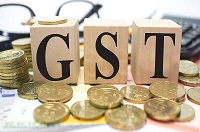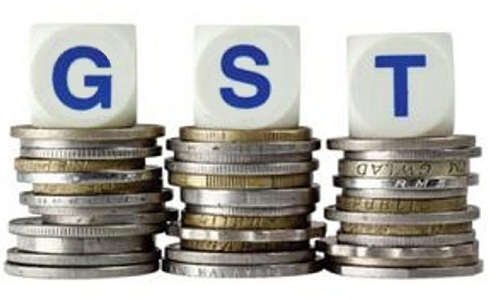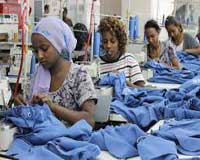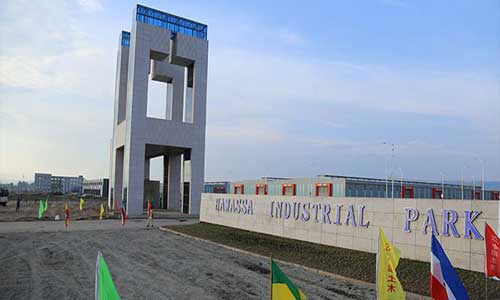FW

Implications on indirect tax
 get subsumed. For textile and its products, the GST
get subsumed. For textile and its products, the GST
Option of tax payment job work in GST
GST and Exports
Uhde Inventa-Fischer, a subsidiary of Thyssenkrupp Industrial Solutions AG will build a polyethylene terephthalate (PET) plant for Sasa Polyester Sanayi A.Ş in Adana, Turkey. The contract was signed in July last year and came into effect in December. With a capacity of 1,050 metric tons per day, it will be one of the largest Pet plants for textile applications worldwide. The product is used for clothing, home textile or technical applications with direct melt feeding to four staple lines and one additional bi-component fiber line.
The design of the poly condensation plant will be based on Uhde Inventa-Fischer’s proven, energy-efficient 2R polyester technology that comprises the patented Espree and Discage reactors. This enables the production of a superior high-quality polyester polymer. A characteristic feature of the plant is that the polymer melt will be conveyed directly from the poly condensation plant to several downstream spinning lines where staple fibers will be produced.
Uhde Inventa-Fischer will handle the basic and detail engineering, provide technical services for erection, pre-commissioning and commissioning supervision and deliver proprietary equipment and key components for the plant. The plant will be completed by the end of 2018.
After agriculture, the textile industry is the second largest employee in the country it contributing about 14 per cent to industrial production and 4 per cent to the GDP. It gives direct employment to around 45 million people. Off late, the industry has gone through lot of difficulties post demonetization and needs special attention in the budget.
Introduction of the GST, reduction of interest rates in parity with the international money market, tax rationalisation measures and incentives for investments in innovation and infrastructure are few of the many demands by the textile industry for the upcoming budget. It should also address concerns related to skilled workforce, labour law reforms attracting investments in the textile sector and providing a future road map for the textiles and clothing industry, it feels.
The textile industry is also of the feel that corporate income tax needs to be lowered to 28 per cent in the upcoming budget and lower it further to 25 per cent in the coming years as promised by FM. The Rs 6,000 crore package announced in 2016 for textiles and apparel sector was a step in the right direction but the industry needs lot of reforms for the revival of the growth. A major challenge for the textile industry is that it is highly capital and labour intensive sector and payback period is quite long which is many a times a big constraint for new investment in the sector.
It needs special attention for the success of Make in India, an initiative launched by Government of India under the leadership of the Prime Minister of India. The government should earnestly consider extending TUFS for another five years or so to enable companies to avail maximum benefit.
Exports are another challenge and industry is well below its targets. The textile industry has asked the finance minister to introduce measures which can boost our exports as India has the potential to become one of the biggest exporters in the world.
Russia will set up its first polyethylene terephthalate complex that would produce textiles. Located in the town of Vichug located in the Ivanov region, the plant is a modern production facility in Russia which is deemed necessary for the industry. An investment of around 25 billion rubles ($419 million) is being made on the project. At present, preparatory procedures are underway, while construction of the complex is planned to start in summer.
Giving details, Pavel Konkov, Governor of the Ivanov region said the modern integrated plant will be capable of producing out almost 200,000 tons of synthetic fiber and yarn per year, The enterprise is scheduled to be launched in the year 2020.
The textile grade Pet production plant will become an anchor project with production volume of up to 200,000 tons of polyester fiber and Pet-chips per year. The Ivanovo region is a part of the Central Federal District of Russia. The governor of the Ivanovo region Konkov said in future a complex of new textile plants will be created, specializing in innovative import substitution products for special and technical purposes with the use of polyester fibers and yarns.
The idea of setting up the plant is to establish its own production of synthetic fibers was born in the even before import substitution became a trend. However, during the implementation some problems came up, the project turned to be capital-intensive, while dependence on imports has not been considered a serious problem. When the plant in Ivanovo region reaches full capacity, it will cover all the needs of Russian producers of raw materials.
With retail sales falling on average by 2 per cent last year and despite the German fashion industry struggling to remain profitable, exhibitors and visitors at the Berlin Panorama were enthusiastic and positive, claimed the event organisers in a press release. The restructuring of the shoe and accessories areas was well received as were the extension of plus-size segment Hipstar and the innovative mix of products.
Visitors also responded well to the launch of a new lingerie hall which complimented the product portfolio at the trade show expanding its footprint to more than 800 exhibitors over a space of 538,000 sq ft. Berlin Panorama CEO Jörg Wichmann said they were aware of the challenging retail environment and have prepared themselves for it. This season there was an increased focus on the retailers. Accordingly, there were a host of inspiration and trend talks as well as various retail-specific seminars. He said that the organizers are optimistic that the current market situation will strengthen the exchange between visitors and exhibitors and thus strengthen the community spirit.
The second day of the event saw an exceptional rise in visitor turnout. Panorama Berlin said it was a significant improvement from previous editions. According to Panorama Berlin, reviews from exhibitors were consistently positive. Mia Fribrog Nielsen, Salas Manager of Danish brand Blend She said that event was a good and international trade show while Christian Schütt, MD of menswear brand Nowadays praised the strong visitor turnout and quality of the mix. The next edition of Panorama Berlin is set to take place from July 4 to 6 with the Spring Summer 2018 collections.
Moda, the leading UK show for lingerie and swimwear will be held from February 19 to 21 at Birmingham. And this time brand Lycra is returning to the exhibition as the headline sponsor. It will showcase new trends and innovations for 2018.
Ensuring that the Lycra is seen as an industry leader in the lingerie and swimwear segments, the brand will showcase a collection of body wear created to demonstrate the brand’s expertise and variety of technologies. Taking centre-stage for product innovations, the Lycra fibre brand keeps ahead with new product developments and boasts a broad range of fibres and fabric concepts including Lycra fibre, Lycra Beauty and Coolmax fabric technology, the company explains in a statement.
With Invista Fashion Directions turning into being a recognised source of inspiration creating value for brands and retailers alike, the Moda show will host Invista’s 2018 must-have trend capsule collection. The collection will feature seven trends and technologies aiming to revolutionise women’s wardrobes, with one of these trends highlighting the growing athleisure trend engaging with the motto I Am Every Woman.
According to Lycra, athleisure makes a statement with the Optimised Self trend reflecting those that work hard to maintain their body balance. Fabrics are enhanced by compressing muscles and optimising performance with the use of Lycra Power technology. Combined with FreshFX technology by Lycra, this fibre innovation is also said to deliver freshness in wear.
Lingerie can be seen as a perfect understated and luxurious base layer with Flawless Me which focuses on mindfulness, peace and tranquillity. On the other hand, Lycra Beauty Cooling is designed to offer sculptural shaping with comfort and freshness and a palette of pale shades is used to match the softness and subtleness of this trend. Swimwear glorifies strong and athletic-looking shapes with Lycra Shaping technology as a key fibre innovation for the My Wild Side trend. Textiles are lightweight and draping with animal skin and tribal prints with camouflage glamour.
In a letter to Bangladesh Prime Minister Sheikh Hasina Wazed, the American Apparel & Footwear Association (AAFA) has addressed the on-going wage concerns, arrests of labour leader and worker terminations. The appeal addresses the fallout from minimum wage disputes in the Ashulia district of Dhaka last month after which 1,600 workers lost their jobs, 600 faced legal charges and 11 garment union leaders were arrested.
The unions also accused security forces with raiding private homes, shutting down union offices and burning membership documents. The AAFA used this opportunity to reaffirm its support for the ‘rights of workers to freely associate, including associated legal protections from harassment, intimidation, and termination for exercising their right to freely associate’. And it says it stands against any illegal actions, be they from workers, labor groups, or factory owners.
AAFA is the latest group to address the ongoing situation including IndustriALL Global Union and UNI Global Union. To quell this and further disputes, the AAFA has suggested regular wage reviews. On behalf of its 1,000 members the organization has called for the swift resolution of the wage issues and arrests in order for the sector to continue to enjoy a healthy relationship with the brands it supplies. The Bangladesh apparel industry employs 4.5 million people and accounts for 83 per cent of the country’s overall exports.
"Ethiopia, the drought-afflicted, landlocked country of 100 million on the Horn of Africa is transforming itself into the lowest rung on the supply chain that pours out fast fashion and five-for-$12.99 tube socks. It is luring companies by tax incentives, state-of-the-art infrastructural investments, and ultracheap labour. Western world who was once outsourcing production to, particularly China and Sri Lanka, are now ramping up production here for Guess, Levi’s, H&M, and other labels. It’s a win-win scenario for both – industrialists as well as the government."

Ethiopia, the drought-afflicted, landlocked country of 100 million on the Horn of Africa is transforming itself into the lowest rung on the supply chain that pours out fast fashion and five-for-$12.99 tube socks. It is luring companies by tax incentives, state-of-the-art infrastructural investments, and ultracheap labour. Western world who was once outsourcing production to, particularly China and Sri Lanka, are now ramping up production here for Guess, Levi’s, H&M, and other labels. It’s a win-win scenario for both – industrialists as well as the government. The recent inauguration of the Hawassa Industrial Park further intensified its positioning. Since 2014, Ethiopia has opened four giant, publicly owned industrial parks; it plans eight more by 2020.
Emerging strong supplier to brands

The industrialists who set up shop here are exempt from income tax for their first five years of business and absolved from duties or taxes on the import of capital goods and construction supplies. Ethiopia can offer such subsidies because it gets lots and lots of money from China: $10.7 billion in loans from 2010 to 2015, according to the China-Africa Research Initiative at the Johns Hopkins University School of Advanced International Studies. Right now, most of the money is being spent on lucrative contracts for Chinese companies that, with help from Ethiopian labor, are building dams, roads, and cellular networks. This infrastructure, the Ethiopian Government says, will allow the country to join the global middle class. Belachew Mekuria, Ethiopian Investment Commission, stated that the plan is to create a total of 2 million jobs in manufacturing by the end of 2025.
Raghav Pattar, VP, Indochine International, says barely six months since the Hawassa Industrial Park opened, and already he has 1,400 locals at work. Pattar is planning to employ 20,000 Ethiopians by 2019. Twenty-four months ago, the land on which the factory is developed was farm fields. Which country can change in 24 months, Pattar asks. He feels, the government is determined towards enhancing industrialisation. Workers toiled 24 hours, day and night, to build the place. And there is no corruption. Hawassa Industrial Park did come up quite fast, thanks to a state-owned Chinese construction company that banged out 56 identical hangar-size, red-and-gray metal sheds devoted to textile production in nine months, for $250 million, according to the Ethiopian Investment Commission. Belay Hailemichael, park manager, helps companies in getting import & export licenses and executive visas and processes prospective workers.
Traditional manufacturing industries are turning to highly automated production modes, like intelligent and efficient textile technology, to enhance efficiency. Through ERP (Enterprise Resource Planning), smart production line is able to automatically control, measure and associate all production processes, with the advantages of costs saving, high efficiency and one-stop management for internal resources.
As most traditional enterprises still use tangible documents to exchange internal information, ERP helps enterprises set up an information system by sharing of data. It effectively ensures the accuracy, completion and immediacy of data. It also consolidates the overall process of purchase, production, orders, sales, transportation and storage, achieving a dynamic balance among different sections of business operations.
With different fabrics and structures as compared to traditional knitwear, functional knitted garments may have more elements that could affect the wearing experience. Ensuring full function while maximizing comfort is the key consideration in functional knitwear development.
With continuous and rapid developments in digital printing technology, digital printing design has become an up-and-coming trend. Digital printing allows flexibility in production, complexity in design, shorter production lead times and energy conservation and green production. Making full use of the Internet in traditional textile and garment production and management processes can greatly enhance competitiveness.
Intertextile Shanghai Apparel Fabrics is the world’s largest apparel fabrics and accessories Fairs. It is held biannually in March (Spring Edition) and October (Autumn Edition). Its popularity can be gauged from the fact that in the upcoming edition many of the biggest names are set to return following strong responses at last year’s two fairs and reports of continued strong demand in China.
The distinctive product zones that have been well-appreciated by exhibitors return again, with the International Hall featuring All About Sustainability, Functional Lab, Premium Wool Zone and Verve for Design. Besides, Accessories Vision and Beyond Denim will also be there. The Premium Wool Zone perhaps best encapsulates the benefits of exhibiting at the Fair for high-end overseas suppliers. Many exhibitors at the last edition reported growth remained strong in China and orders were still being placed at the Fair including Harrisons of Edinburgh who returns this March.
Many exhibitors in the Premium Wool Zone last year emphasised differences in consumer preferences around wool products in China, making the Fair vital to understand the market’s needs. Some of the wool and cashmere fabrics exhibitors from Peru and the UK have already confirmed to partake in the Fair. They include Aris Industrial, Beijing Vitality Textiles, Harrisons of Edinburgh, Huddersfield Fine Worsteds, Loa Hai Shing, Merino Brothers and Scabal.
While the Premium Wool Zone has been a mainstay for a number of years, Beyond Denim is a relative newcomer reflecting its growing importance in the industry. This edition’s Beyond Denim is expected to see 100 exhibitors from China and abroad.
Again, some of the industry’s leading producers will feature here such as Orta Anadolu from Turkey, China’s Advance Denim, Changzhou Henglun Textile, Jiangsu Zhongheng Dyeing & Finishing, Knit Denim Hengliang Textile and Prosperity Textile, while from Pakistan Diamond Denim by Sapphire, Diamond Fabrics and Indigo Textile are amongst those exhibiting.












